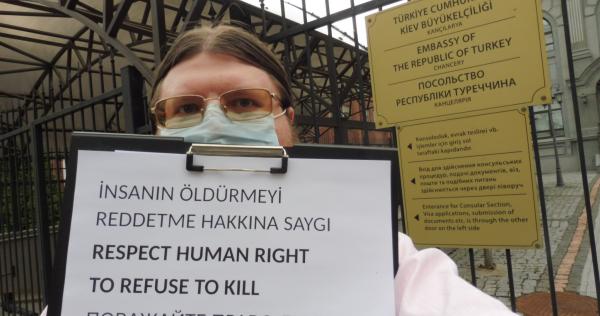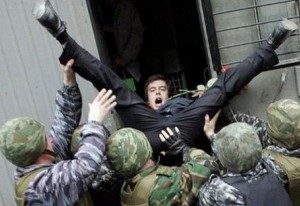
Call for the US to Support Russian, Ukrainian,
And Belarusian Conscientious Objectors
Fellowship of Reconciliation / Organizational Sign-on Letter
Dear President Biden,
(September 2022) — We the undersigned ask that you grant immediate asylum and assistance to Russian, Ukrainian, and Belarusian conscientious objectors and dissenters.
Since President Vladimir V. Putin announced a new troop call-up on September 21, 2002, eligible Russian men have been fleeing the country in droves to escape the draft. However, neither the US nor Europe have changed the policies that make it difficult for Russians to enter.
There are an estimated 100,000 Russian military draftees and deserters refusing the war of aggression. An estimated 22,000 Belarusian military draftees have left their country because they don’t want to participate in the war in Ukraine.
Ukraine suspended the right to conscientious objection and closed the border for men between 18 and 60. Over 100,000 men have evaded war involvement in Ukraine and fled abroad.
Everyone who has refused service risks persecution — up to ten years for Russian draft dodgers — because of their stand against the war. These brave men are our hope for peace and they need protection.
Instead of continuing to provide weapons — at least $20 billion in military assistance to Ukraine as of September 8, 2022 — that prolong and escalate this war that could easily result in nuclear catastrophe, we call on you to support and grant asylum to Russian, Ukrainian, and Belarusian conscientious objectors and deserters.

Desertion in Order to Not Participate in War
Numbers for Russia, Belarus and Ukraine
(September 15, 2022) We know that thousands of military conscripts have fled Russia, Belarus and Ukraine. But it is not possible to obtain accurate numbers on desertion, conscientious objection to military service and military draft evasion in these countries. No statistics record how many there really are. Therefore, at this point we can only try to estimate those numbers.
Who Is Obliged to Go to the Army?
In all the countries mentioned above, compulsory military service is from 18 years to 27 years. But in cases of war this age limit is pushed up. Reservists in particular can be called up for wartime service. For example, the Russian government raised the age limit for possible conscription of contract soldiers to 65 at the end of May 2022.1
Ukraine already adopted an exit ban for potential recruits in February, at ages between 18 and 602 and suspended the right of conscientious objection to military service3. Women have so far been exempt from these regulations; they are not subject to conscription in these countries. However, women with war-related occupations, such as in the medical field, can be recruited.
It should also be noted that the regulations can change at any time during the course of the war. In our estimate, we assume that the soldiers who are drafted and deployed for military service (regardless of which of the warring parties) basically come from the group of 18 to 60 year-old males.

Exemptions
There are a number of exemptions for enlistment in all of these countries. For example, there is the possibility of exemption from service, which is frequently practiced, especially in Russia and also Belarus, also by means of corruption. There is a chance of being deferred because of education or studies at universities. Conscientious objection to military service is an option, which, however, is handled very restrictively in Russia and Belarus. In Ukraine that right has been suspended at the beginning of the war.4 In the separatist areas that option is not available.
Currently, Russia is conducting the war as a so-called Special Operation and claims that no conscripts are being deployed in Ukraine, only contract soldiers. However, various examples show that conscripts are coerced into signing contracts, so they find themselves in Ukraine unawares.5 We also receive individual reports that reveal that other people are also being recruited.
To reflect the exemptions in the figures, we have reduced the existing figures on men between 18 and 60. In the case of Russia, we thus assume that only 70% of the men aged 18 to 60 could really be recruited in the country of origin according to the current specifications.
In the case of Ukraine, since many have left the country with such an exemption, we even assume here that only about 50% of the fled men aged 18 to 60 could really be recruited in the country of origin according to the current specifications.
In all of this, it should also be noted that the situation for conscripts and reservists can change at any time due to the war situation. This also applies to the possible recruitment of women. It cannot be ruled out that if the war continues, a larger group of people could be recruited, exemptions and deferrals be lifted, or that the military becomes more open or mandatory to women.

Flight and Destination Countries
Russia
In May 2022, OK Russians published a study on the topic of flight from Russia. The study speaks of 300,000 dissidents having left Russia by mid-March.6 Destination countries, according to Wikipedia,7 are mainly Georgia (100,000), Turkey (100,000), Armenia (50,000). But some also leave for countries like Serbia (30,000), Montenegro, the Baltic States, Kazakhstan or Israel (17,000).8 In all of Western Europe, there were just 4,660 asylum applications from Russian nationals from January to June 2022.
In September, figures from Rosstat, the official statistics agency in Russia, became public. According to these figures, 420,000 people left Russia in the first half of 2022. This is the balance of emigration and immigration or return.9
Another estimate speaks of over 1,000,000 refugees from Russia.10 Ultimately, it is not clear, but we must certainly assume several hundred thousand refugees. Due to the different figures, we take here the official emigration of 420,000 persons given by Rosstat as the basis for further calculations.
The movement of refugees from Russia also has a lot to do with the fact that the political climate has deteriorated and the restrictions imposed on opponents and critics of the war have been tightened considerably. Many had taken to the streets or protested on social media against the start of the war. This was harshly prosecuted by the police and security authorities. Thus, as OK Russians states, this was also one of the main reasons for leaving the country.
On the other hand, we must also see that all men who are in principle subject to military service may also be potential recruits, even if that is not their main reason for fleeing in the first place. And the opposition to the war also shows that they may have little interest in being drafted into it.
Therefore, the question is, how many men and women are among the refugees? And how many men are of the appropriate age? Here, Eurostat’s statistics on asylum application numbers can give a clue.
Eurostat indicates that from January to June 2022, a total of 4,660 asylum applications were filed by Russian citizens, including 1,780 applications by men between the ages of 18 and 64. If we take out the last four years proportionately, , there would be about 1,600 men aged 18 to 60. This would correspond to about 1/3 of the total number of asylum applicants in the same period.
That is why we assume that about 1/3 of the refugees from Russia are between 18 and 60 years old. If we assume a total number of refugees of 420,000, we would thus be at 140,000 men in these age groups. Above we have already stated that due to the exemptions in our estimate we reduce this number by 30%, which brings us to a figure of nearly 100,000 men subject to military service who left the country.
| Flight from Russia – January to June 2022 | ||
| 1 | Total number of refugees | 420.000 |
| 2 | Men between 18 and 60 years (1/3 of pos 1) | 140.000 |
| 3 | Men subject to military service (70% of pos 2) | 100.000 |
Thus, with regard to Russia, we come to the conclusion that nearly 100,000 men potentially subject to military service are estimated to have left the country.
Belarus
The Belarusian organization Nash Dom, working from exile in Lithuania, has initiated the “NO means NO” campaign early on and also has widely publicized via social media its call to evade a possible war deployment.
According to the latest figures collected by the organization, we must assume similar target countries here as with Russia. Unfortunately, estimates are only available for Lithuania and Georgia. Thus, Nash Dom speaks of 2,000 having gone to Lithuania and 20,000 to Georgia.11
Thus, with regard to Belarus, we come to the conclusion that more than 22,000 men subject to military service are estimated to have left the country.

Ukraine
UNHCR regularly submits new reports for the Ukraine.12 According to their assessment, by mid of September 2022 4,040,000 refugees from Ukraine were registered in the European Union. There were also 2.6 million who fled to Russia. However, due to the lack of figures on onward migration, it is completely unclear how many remained there. Rosstat indicates for the first half of 2022 that about 60,000 Ukrainian citizens have been granted temporary residency.13
In some detailed statistics UNHCR states how many of the Ukrainian refugees are children (up to 18 years old) or women and men. For example, for the Czech Republic UNHCR registered until mid of September about 407,000 refugees, including 47% women, 34% children and 20% men between the ages of 18 and 64.14 Accordingly, there are 75,808 men from Ukraine in the Czech Republic.
For our estimation, we reduce the number by the last four cohorts, so we arrive at nearly 70,000 men from Ukraine in the Czech Republic between the ages of 18 and 60, i.e. of military service age, equivalent to 17% of the total number of refugees registered in the Czech Republic. As shown above, we reduce this number by 50% due to the exemptions to military service, thus arriving at the assumption that there are about 35,000 men from Ukraine subject to military service in the Czech Republic.
| Flight from Ukraine – Refugees in the Czech Republic | ||
| 1 | Total number of refugees | 407.000 |
| 2 | Men between 18 and 60 years | 70.000 |
| 3 | Men subject to military service (50% of pos 2) | 35.000 |
Other UNHCR statistics estimate that 10-14% of registered refugees are men over 18 years of age.15 Current figures now available show that the proportion of men in Western Europe is less than 10%.16 We therefore reduce our estimate with respect to Western Europe countries as a whole and assume that 8% of Ukrainian refugees registered in Western European countries are men in the age of 18 to 64. Reducing the number by the last four cohorts we thus arrive at a total of about 290,000 men subject to military service who have left Ukraine for Western European countries.
Above we have already stated that in our estimate due to the exemptions, we reduce this number by 50%, which brings us to a figure of about 145,000.
| Flight from Ukraine – Refugees in European Union | ||
| 1 | Total number of refugees | 4.040.000 |
| 2 | Men between 18 and 60 years | 290.000 |
| 3 | Men subject to military service (50% of pos 2) | 145.000 |
Therefore, with regard to Ukraine, we come to the conclusion that more than 140,000 men subject to military service are estimated to have left the country.
Why don’t these numbers appear in public reports?
We ourselves are surprised by this result, especially with regard to Ukraine. It is hardly known to the public that so many men have fled Ukraine, escaping the war effort. There is also almost no one who wants to go public with this story (even anonymously). At Connection e.V. we receive inquiries about Ukrainian conscientious objectors almost daily, but almost always from relatives or friends, and very rarely from the affected men themselves.
We assume that, on the one hand, the public interest is much more focused on the refusal in Russia (and Belarus). Currently the Ukrainian conscientious objectors have no reason to talk publicly about their status, because they have obtained at least temporary humanitarian residence in the European Union. Furthermore they probably fear defamation and branding as traitors and therefore prefer to remain in the background.
Footnotes
1 Radio Free Europe, May 25, 2022, https://tiny.one/m55axsw9
2 The Washington Post, March 22, 2022, https://tiny.one/mtmpd7fw
3 https://de.connection-ev.org/article-3614
4 ibid.
5 https://ebco-beoc.org/node/529
6 OK Russians, March 2022, https://research1.okrussians.org
7 https://tiny.one/mse9ns6u, viewed 9/15/2022
8 Tageblatt, Luxemburg, 22.4.2022; Süddeutsche Zeitung, 22.7.2022
9 Deutsche Welle, 6.9. 2022, https://tinyurl.com/yhjem2a9
10 Deutsche Welle, 5.4.2022, https://tinyurl.com/u83zbjs7
11 https://de.connection-ev.org/article-3547
12 UNHCR: Ukraine Refugee Situation, https://tinyurl.com/2ves77dy, viewed 9/15/2022
13 Социально-экономическое положение России, январь-июль 2022 го
